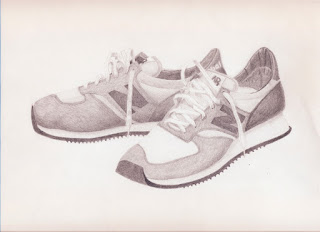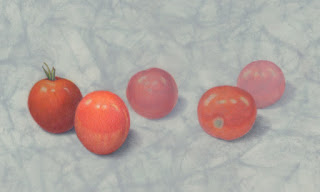If you have studied composition and painting with me, you remember I do a great deal of thinking, planning and experimenting BEFORE I begin painting. This is where the “real” work is for me. I have a checklist of steps I rely on to carry me through the entire painting process – and painting is all about process for me. Once I know what I’m doing and where I’m supposed to go, vis-à-vis the checklist of steps, I’m completely free to enjoy completing the work.
The painting part is truly joyful for me! If I get interrupted (I frequently do!) anywhere along the process, I refer to the checklist to find my way back to the step needed to resume my work. The steps not only keep me organized and on track, I also stay connected to why I’m painting this particular piece. Having this check list has resulted in more economical use of my limited time in the studio.
Paradise, Colored Pencil on Film © Kathie Miranda
Painting (verb) is all about making a mark and responding to it. The finished painting (noun) is a whole lot of marks with corresponding responses from me – the artist. This concept is not stifled by the checklist of steps; rather the steps allow me to alter my painting choices along the way while keeping me faithful to my story:
Step 1: Your Story
Why are you painting this particular subject? What caused you to choose it over a million other ones? What caught your attention: a childhood memory? Access to a rare specimen found during your travels? Once you articulate it, write it down in a few words. Keep it visible as you work. Every creative decision you make should reflect your story.
Step 2: Value and DOS Studies
Once my composition is selected from initial thumbnail drawings, I create a full-scale, detailed outline. I then make two photo copies of the outline, reduced to ~ 25%. On one copy I do a value study – at least 3 but no more than 5 values. On the other copy I do a DOS study – depth of space – to determine where each element of my plant resides in space – foreground, midground or background. These studies are important to assess the composition and to make corrections at this stage if something doesn’t feel right.
DOS Map
Step 3: Pull Your Palette
Work from life here, if at all possible. See the plant in its habitat, in the lighting conditions as you encountered it in the field. Once you match all the colors you need for the painting, label them for future reference.
Step 4: General to Specific
 |
| Grisaille |
For me, the first layer is often a grisaille which defines the form of individual elements across the entire piece.
Either approach becomes a map for subsequent color layers.
Step 5: Refine the Shapes
With the large shapes blocked in (or the grisaille in place), break these shapes into smaller ones to build local colors. Proceed as though each element is smooth; i.e., avoid adding detail at this stage.
Step 6: Define the Edges
As the image begins to take its final shape, turn your attention to the edges. Are they hard edged? Soft edged? Turning edges? Hard edges advance; soft edges recede. Round objects have no edges! We indicate their shape with soft, diffuse edges of value and color. Speaking of color, look closely at the color of edges: botanicals often display surprising colors there.
Step 7: Transitions and Details
If time allows, put the painting away for a few days, and then bring it out again to look at it from a “museum distance” (from across the room). Consider the transitions of values and colors – smooth and seamless? Are the edges contributing to convincing depth of space?
Make any necessary adjustments before proceeding to the final details. Remember less is more!
Step 8: Sign Your Name
Once you are satisfied that more marks will no longer contribute to the whole, you are finished! Sign your name.


































































